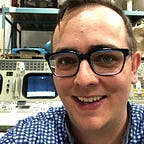The Falcon Has Landed
On July 30th, 1971, the Lunar Module Falcon touched down, roughly 10 degrees off level, at the Hadley landing site. Thankfully, the lunar module was designed to be able to launch at up to a 15-degree angle, so the Falcon was still within its design limits. Still, it made for a dramatic scene when you look at the pictures of the Lunar module on the surface.
Apollo 15 was a longer J type mission, with longer lunar EVAs and the use of the Lunar Rover. Types A and B were uncrewed missions that tested the Command and Service Module (CSM) and Lunar Module (LM). Types C-F were all test missions, from lunar orbit to the “dress rehearsal” Apollo 10 mission.
The G type mission was for Apollo 11 and H-I mission types were flown for Apollo 12–14. The buildup to longer duration, more capable missions culminated with the final three Apollo missions. Crews on Apollo 15, 16, and 17 used the Lunar Rover to explore farther away from the LM during the multi-day stays on the Lunar surface.
David Scott became the first person to drive a vehicle on the surface of another world, and James Irwin became the first to ride shotgun when they drove the rover that had been stored on the LM Falcon. The Lunar Rover allowed them to travel farther away from the landing site than ever before. This enabled them to collect samples from more places on the Lunar Surface, an important part of understanding the geology of our moon. (David Scott and James Irwin are pictured here during geology training.)
Over the course of their stay on the surface, Scott and Irwin conducted three surface EVAs. During the final EVA, Scott and Irwin performed an experiment to show the effect of gravity on all objects is the same. Scott dropped a hammer and a feather at the same time, and because of the lack of an appreciable atmosphere on the moon, both objects fell at the same time.
Scott also left behind a memorial to the fallen astronauts and cosmonauts that had lost their lives. It was a simple plaque, with the names of astronauts bordered by simple lines. Beside it, he placed a small aluminum sculpture with a vaguely humanoid form. There is controversy as to what the sculpture represents, but its seen as the “fallen astronaut” statue. We will talk more about this statue in an upcoming post.
Scott and Irwin stayed on the Lunar surface from July 30th to August 4th. During their time on the surface, they spent about 18.5 hours on the lunar surface conducting EVAs. They brought back one of the most famous lunar samples to Earth, the so-called Genesis rock, a piece of the moon’s early crust. Learn more about this rock by clicking this link.
Over the next few days I will have more on this mission, so be sure to like, share, and follow me for more!
Picture Credit- NASA
